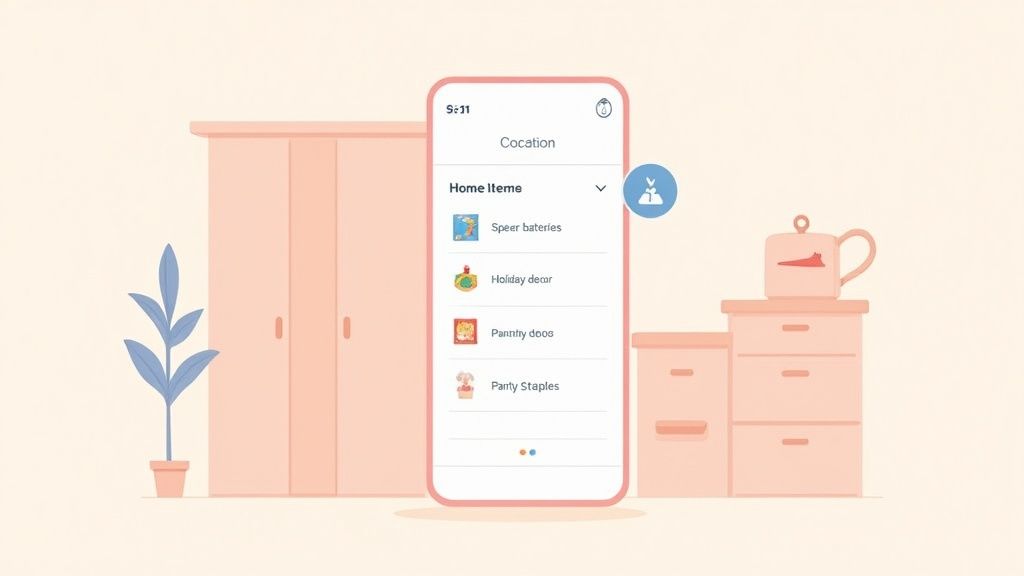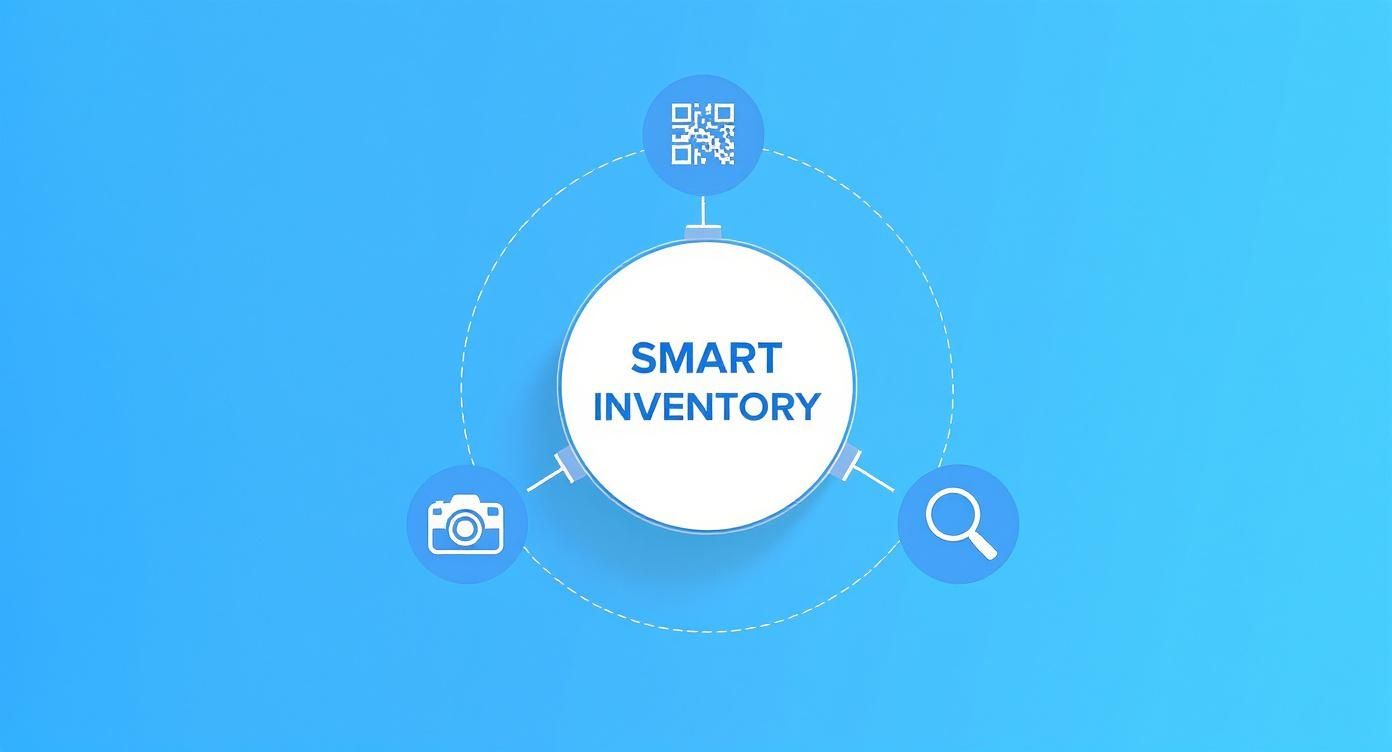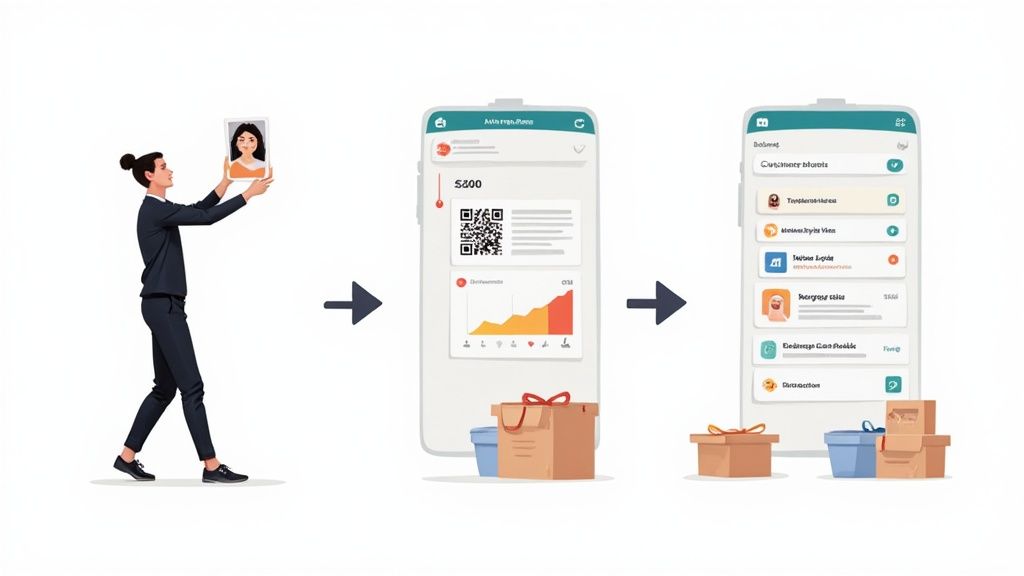Imagine knowing exactly where everything is, from the spare batteries to that one specific holiday decoration, without having to tear the house apart. That’s the simple promise of automated inventory management for your home. It uses smart tech to catalog what you own, remember where you put it, and just generally help your household run a whole lot smoother.
Your Home’s Digital Concierge
Forget those complex business systems. Think of this as a personal digital concierge for all your stuff. Instead of relying on a shaky memory or messy spreadsheets, this modern approach uses an app to build a complete, searchable catalog of everything you own. It takes the frustrating chore of tracking your possessions and turns it into an almost effortless, automated process.
This system essentially becomes your home's central brain. It remembers that the holiday lights are in the attic, the extra lightbulbs are in that cabinet in the garage, and the warranty for your new coffee maker is stored safely as a digital file. By putting all that information in one place, it cuts out the daily friction of finding, managing, and organizing your things.

From Chaos to Control
The whole idea is to swap manual effort for intelligent assistance. For instance, instead of typing out every single item you buy, you can just snap a picture of it, and the app figures out what it is for you. This shift from manual tracking to automated cataloging is what makes the whole system so powerful.
The core goals of a good home inventory system are pretty straightforward:
- Create a single source of truth: One reliable place to see everything you own and its precise location.
- Reduce your mental load: Offload the job of remembering where thousands of different items are stored.
- Save time and money: Stop wasting minutes searching for things and quit buying duplicates of items you already have.
- Improve household coordination: Let family members or roommates tap into a shared, synced inventory so everyone’s on the same page.
To see the difference clearly, let's compare the old way with the new way.
Manual vs. Automated Home Inventory: A Quick Comparison
| Feature | Manual Inventory (Spreadsheets, Notebooks) | Automated Inventory (Apps like Vorby) |
|---|---|---|
| Data Entry | Tedious and time-consuming; you type everything by hand. | Fast and easy; snap a photo, scan a receipt, or forward an email. |
| Searchability | Limited to basic text search (Ctrl+F), if digital. Impossible with notebooks. | Powerful and visual; search by name, category, location, color, or even a photo. |
| Maintenance | A constant chore; requires disciplined manual updates for every change. | Effortless; updates sync automatically across devices. |
| Visuals | None. It's just lines of text, which doesn't help you remember what an item looks like. | Richly visual; every item has photos, making identification instant. |
| Accessibility & Sharing | Difficult to share and keep in sync. A spreadsheet can only be edited by one person at a time. | Simple; share access with family so everyone knows where things are. |
| Insurance Preparedness | Better than nothing, but often incomplete and hard to prove ownership. | Comprehensive; creates a detailed, photo-documented record for claims. |
The table makes it obvious: while manual methods were a good first step, technology offers a far more effective and less frustrating solution.
An automated system gives you more than just a list; it provides genuine peace of mind. Knowing exactly what you have and where to find it empowers you to manage your home with a new level of confidence and efficiency.
Ultimately, an automated inventory management app like Vorby brings this concept to life, making home organization feel less like a dreaded chore and more like a seamless part of your daily routine.
The Technology Behind Your Smart Inventory
Automated inventory management feels a little like magic, but it’s actually a clever mix of powerful technologies working together right on the smartphone you already own. There’s no complex machinery involved. Instead, these systems use a few key pieces of a technological puzzle to turn a room full of physical clutter into a neatly organized digital list.
This same approach has been a game-changer for businesses for years, and now it's finally making its way into our homes. The global market for this kind of software is set to nearly double to $4.79 billion by 2032, all because automation and AI make life so much easier. You can see these trends for yourself over on Fortune Business Insights, but the big takeaway is that the same powerful principles are now simplifying home organization for everyone.
AI Image Recognition Sees Your Items
The heart of any modern inventory app is AI-powered image recognition. Think of it as a digital brain that’s been trained to recognize millions of different objects from a single photo. When you snap a picture of a board game, a power tool, or that forgotten kitchen gadget, the AI analyzes the image, compares it to a massive visual database, and instantly suggests a name and category for it.
For instance, you could take a quick, messy photo of a pile of new books. The system can often identify the individual titles, authors, and even the cover art, saving you from typing a single word. This is what makes it possible to digitize your belongings in minutes, not hours of tedious manual entry. If you want to go deeper on this, we break down exactly how AI is changing home inventory in our detailed guide.
Receipt Scanning Captures Purchase Details
Another incredibly useful feature is receipt parsing. This technology goes beyond just knowing what an item is; it extracts all the crucial details directly from your receipts. Just take a picture of a paper receipt or forward a digital one from your inbox, and the system automatically pulls out key info like:
- The exact item name and description
- The purchase price and date
- The store where you bought it
- Warranty information and return deadlines
Suddenly, you have a rich, detailed record for every item, which is a lifesaver for insurance claims, warranty management, or just keeping an eye on your spending.
By combining image recognition with receipt scanning, an automated inventory system builds a comprehensive profile of your belongings. It knows not just what you have, but also its value, its origin, and its history.
QR Codes and NFC Tags for Physical Organization
So, you’ve logged all your items. But how do you connect that digital record to a specific box tucked away in the attic? That’s where QR codes and NFC tags come in. You can generate a unique QR code for any container (a storage bin, a moving box, you name it). Slap that code on the outside, and a quick scan with your phone instantly pulls up a complete list of what’s inside.
NFC (Near Field Communication) tags are even slicker. They work the same way, but you just tap your phone to the tag for an instant lookup. It's perfect for labeling pantry shelves or office drawers, creating a seamless bridge between your physical space and your digital inventory.
Real-World Benefits of an Organized Home
An organized home is about so much more than just looking tidy. It's about how your space feels and how it functions for you every single day. The real magic happens when you get a handle on your stuff. It's a change that brings tangible, practical benefits, saving you time, money, and a whole lot of stress.
Think about the last time you tore the house apart looking for something important, like your passport or a spare set of car keys. That frantic energy is exhausting. Studies show the average person wastes several minutes every single day just hunting for misplaced items. An automated system hands that time right back to you.
Save Time and Cut Down on Frustration
The most immediate payoff? You get to stop playing hide-and-seek with your own belongings. Consider your holiday decorations. Instead of a frustrating treasure hunt through every dusty box in the garage, a quick search in an app like Vorby tells you exactly where they are: "Garage, Bin #3." Done.
This isn't just for seasonal stuff, either. It applies to the little things that drive you crazy, such as finding that specific charging cable, a fresh pack of batteries, or the board game your kids are begging to play. What used to be a 10-minute scavenger hunt becomes a simple, stress-free search.
This concept map breaks down the core technologies that make finding your items so seamless.

As you can see, powerful features like image recognition, QR codes, and smart search all work in concert to build a reliable digital map of your home.
Protect Your Wallet and Your Peace of Mind
Getting organized has a direct impact on your bank account. How many times have you bought a new tube of caulk or a pack of lightbulbs, only to discover you already had three tucked away in a drawer? Nixing those duplicate purchases can lead to some serious savings over the year.
Beyond that, a well-documented inventory is an absolute lifesaver for insurance purposes. If the unthinkable happens (a fire, flood, or burglary), having a detailed list with photos and receipts is your best defense. It simplifies and speeds up your claim, ensuring you get fair compensation for your valuables by replacing guesswork with hard proof.
The ultimate benefit is peace of mind. Knowing exactly what you own and precisely where to find it gives you a feeling of control and readiness, whether you're just living your daily life or facing something bigger.
Take moving, for example. Slapping a QR code on each box lets you see its contents on your phone without ever needing a box cutter. That one simple step can transform a chaotic ordeal into a structured, manageable project.
An automated inventory management system really acts as your digital safety net, bringing a sense of order to the beautiful chaos of home life. It’s a proactive approach that quiets those little daily anxieties, freeing up your mental space for the things that truly matter.
How Real People Use Home Inventory Systems
An automated inventory management system isn't a rigid, one-size-fits-all tool. Its real magic is in how it molds to your life. The organizational challenges of a busy family are worlds apart from those of someone moving to a new city, or a collector managing a prized collection.
A smart inventory app gets this. It adapts. The same core technology can be a game-changer for completely different needs, moving beyond a simple list to solve real-world headaches. Let's dig into how different people can get the most out of it.
For Busy Families Drowning in Daily Chaos
For families, life is a beautiful, chaotic whirlwind. Keeping track of everyone's gear can feel like a full-time, unpaid job. An automated inventory system acts like a shared household brain that everyone can access from their phone.
Think about the classic scramble to find your kid's soccer cleats ten minutes before the game. Or standing in the grocery store, trying to remember if you have any pasta left. With a shared inventory, a quick search settles it instantly.
Here’s how a family puts it to work:
- Track Sports and School Gear: Assign each child's equipment (uniforms, instruments, backpacks) to their profile. You'll always know who has what and where it's supposed to be.
- Tame the Pantry: Scan groceries as you put them away to keep a live view of what's in the kitchen. Anyone at the store can check the app and stop buying duplicates. No more coming home with a third jar of mustard.
- Coordinate Shared Stuff: Finally, a way to keep tabs on the board games, power tools, or camping gear that everyone uses but no one can ever seem to find.
For People Moving to a New Home
Moving is consistently ranked as one of life's most stressful events, but an inventory system can bring an almost shocking amount of order to the chaos. Creating a digital manifest of your belongings turns the process from a guessing game into a well-oiled project.
Instead of scribbling half-legible labels on boxes, like "Kitchen - Misc.", you create a clear, searchable record of exactly what's inside. This makes both packing and unpacking remarkably efficient.
The core idea is simple: pack once, find forever. By linking physical boxes to a digital inventory, you eliminate the frustration of ripping open ten different containers just to find the coffee maker.
Here's how movers can do it, step-by-step:
- Assign QR Codes: Generate and print a unique QR code for every single moving box.
- Scan and Pack: As you place items into a box, snap photos or scan their barcodes to add them to that specific box's digital list.
- Find Anything Instantly: After the move, instead of guessing, just scan any box's QR code with your phone to see a complete list of its contents. No more box-opening roulette.
For Passionate Collectors and Hobbyists
Collectors and hobbyists get it. They understand the deep satisfaction of meticulous organization. Whether it’s vintage comic books, fine wine, or rare sneakers, each item has a story and a value that needs to be tracked with precision. An automated inventory system is the perfect platform to manage a collection professionally.
This level of detailed tracking isn't unlike what large warehouses use. In fact, many commercial operations now use autonomous systems like robots and drones for real-time inventory counts to boost accuracy. You can read more about the future of inventory management on ccals.com, but the same principles of precision apply to a personal collection.
For collectors, the system is indispensable:
- Catalog Every Detail: Log acquisition dates, purchase prices, condition notes, and high-res photos for each piece.
- Track Value and Appreciation: Add current market values to see how your collection's worth changes over time.
- Organize for Insurance: Instantly generate the detailed, photo-documented reports required for proper insurance coverage, protecting your investment against the unexpected.
Getting Started with Automated Inventory

The idea of creating a complete automated inventory of your home can sound intimidating. Visions of a weekend lost to scanning barcodes and typing up lists might even make you want to give up before you start. But here’s the secret: the goal isn’t to catalog your entire life in one go. It’s about building a simple, sustainable habit that brings order to your space, one small victory at a time.
This isn't about some massive, overwhelming project. It’s a practical roadmap to get you from feeling disorganized to feeling in control, starting with the right tool. You’ll want an app that feels intuitive and rewarding, not like another chore on your to-do list, something that balances powerful features like AI image recognition with a design that just makes sense.
Your Action Plan for an Organized Home
The biggest mistake people make is trying to tackle the whole house at once. That’s a fast track to burnout. The smart approach is to pick one single, contained area that drives you crazy on a daily basis. Think of your kitchen junk drawer, the hall closet that’s always overflowing, or the tangled mess of cables under your desk.
Conquering that one small space will give you the momentum you need to keep going. Here’s a simple process that works every time:
- Choose Your Starting Point: Pick one small, manageable space. The satisfaction you get from organizing it will fuel your motivation for the next one.
- Take Clear Photos: Snap a few pictures of each item against a clean, simple background. Good lighting is your best friend here because it helps the AI identify everything much more accurately.
- Use Descriptive Tags: Think like you're searching for something. Add relevant tags like "electronics," "winter clothes," or "craft supplies." This is what makes finding things later lightning-fast.
- Organize into Logical Spaces: Inside the app, create digital "spaces" that mirror your real ones. Get specific, like "Pantry Shelf 2" or "Under Sink Cabinet."
This methodical approach is the key. For a more detailed walkthrough, our guide on how to take an inventory of your belongings is a great place to build your foundation.
The most effective inventory systems are built gradually. Think of it like a puzzle; each organized space is another piece falling into place, revealing a clearer, more manageable picture of your home.
Unlocking Advanced Features
Once you’ve got the basics down, you can start exploring the tools that truly set an automated system apart. This is where you go from just being organized to running your home with incredible efficiency. While big businesses use AI to cut their inventory holding costs by up to 20%, you can apply the same core ideas to save time, money, and stress. You can dive deeper into how AI is changing inventory control with this article from the experts at Leafio.ai.
Here’s how to start thinking like a pro:
- Generate QR Codes for Storage Boxes: This is a game-changer. Print unique QR codes and stick them on those mystery bins in the garage or attic. A quick scan with your phone instantly shows you everything inside, so no more tearing open box after box looking for the holiday decorations.
- Set Reminders for Warranties: When you add a new appliance or gadget, snap a picture of the receipt and set a reminder for when the warranty or return window is about to expire. It’s a simple trick that can save you a lot of money.
- Track Consumables: Use the app to keep an eye on things you use up, like pantry staples, cleaning supplies, or printer ink. A quick glance tells you exactly what you need on your next shopping trip. No more guessing.
Your Privacy and the Real Return on Your Investment
Let's talk about the elephant in the room. When you start cataloging everything you own with an automated inventory management system, it’s completely natural to wonder about privacy. You're documenting the contents of your life, after all. You absolutely need to know that your information is locked down and safe from prying eyes.
Any app worth your time makes security its number one job. Look for platforms that treat robust security as a baseline feature, not an optional extra. The gold standard here is end-to-end encryption, which basically scrambles your data into an unreadable code that only you can unlock. Not even the app provider can see what you’ve inventoried.
Beyond the technical stuff, transparency is a huge tell. A company you can trust will have a privacy policy written in plain English, not confusing legalese. It should tell you exactly what data they collect (and what they don't) and how it’s handled. For a solid example of what this looks like in practice, you can see Vorby's commitment to user privacy.
Calculating Your True Return
While security is non-negotiable, the practical return on your investment (ROI) is what will make you stick with it. And I'm not just talking about money, though you’ll definitely save cash by not re-buying things you already have. The real value is measured in reclaimed time and a massive reduction in daily stress.
The ROI of an automated inventory system isn't just about dollars and cents. It's calculated in the minutes you get back every day, the peace of mind from knowing where everything is, and the quiet satisfaction of a clutter-free mind.
Think about the small cost of a monthly subscription versus the huge, tangible benefits you get in return.
- Time Saved: How many minutes did you burn last week hunting for that one specific cable, the holiday decorations, or your passport? An automated system turns those frantic searches into a five-second task.
- Money Saved: Stop buying duplicates. It’s that simple. A quick search before you head to the store or click "buy now" prevents you from spending money on things you already own but forgot about.
- Stress Reduced: The mental load of trying to remember the location of thousands of items is exhausting. Offloading that entire job to an app frees up your brainpower for things that actually matter.
When you weigh that small cost against these life-changing gains, the value becomes crystal clear. An organized home is a direct investment in a calmer, more focused, and more efficient life.
Got Questions? We've Got Answers
Jumping into something new always brings up a few questions. If you're wondering about making the switch to an automated inventory, you're not alone. Here are the honest answers to what people usually ask.
Is It Difficult to Catalog Everything I Own?
Honestly, trying to do it all at once would be a nightmare. Don't do that.
The key is to start small. Forget about tackling the entire house, since that’s a recipe for burnout. Pick one small, manageable space. Your office bookshelf. The kitchen pantry. That one closet you've been avoiding. Apps with AI image recognition do the heavy lifting, turning a tedious manual chore into a quick photo session.
The momentum you get from organizing one small space is real. Once you conquer one area, the next feels less like a chore and more like a win.
How Secure Is My Data in a Home Inventory App?
This is a big one, and it should be. Reputable apps treat your data like a bank vault. The gold standard to look for is end-to-end encryption. It’s a technical term, but it simply means that your data is scrambled from the moment it leaves your device until you access it again. No one else, not even the app provider, can see what you’ve stored.
Always take a minute to check an app's privacy policy. A trustworthy company will be upfront about their security measures and how they keep your personal information locked down.
Is an Automated Inventory System Really Worth the Money?
For most people, it's a definite yes. Think about the hidden costs of being disorganized. How many times have you bought a new set of batteries or another tube of caulk, only to find one you already owned a week later? How many hours have you wasted tearing the house apart looking for that one specific thing?
A small subscription often pays for itself surprisingly fast, both in money saved and stress avoided. It’s less of an expense and more of an investment in your own sanity and a smoother-running household.
Ready to trade chaos for calm? With Vorby, you can snap photos of your stuff, find anything in seconds, and keep the whole family in sync. Start your free 14-day trial today and feel the difference for yourself!



